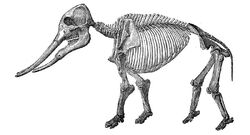m (Protected "Mastodon" [edit=autoconfirmed:move=autoconfirmed]) |
m (fixing dead links) |
||
| Line 1: | Line 1: | ||
| − | |||
{{Taxobox |
{{Taxobox |
||
| color = pink |
| color = pink |
||
| Line 40: | Line 39: | ||
*http://www.calvin.edu/academic/geology/mastodon/calvin_c.htm |
*http://www.calvin.edu/academic/geology/mastodon/calvin_c.htm |
||
*http://www.amnh.org/exhibitions/expeditions/treasure_fossil/Treasures/Warren_Mastodon/warren.html?acts |
*http://www.amnh.org/exhibitions/expeditions/treasure_fossil/Treasures/Warren_Mastodon/warren.html?acts |
||
| − | * |
+ | *https://archive.is/20121205024835/www.bbc.co.uk/nature/wildfacts/factfiles/3004.shtml |
*http://www.priweb.org/mastodon/mastodon_home.html |
*http://www.priweb.org/mastodon/mastodon_home.html |
||
*http://www.mostateparks.com/mastodon.htm |
*http://www.mostateparks.com/mastodon.htm |
||
Revision as of 01:28, 17 August 2014
| iMastodon | ||||||||||||
|---|---|---|---|---|---|---|---|---|---|---|---|---|
 Mastodon skeleton
| ||||||||||||
|
Pre
| ||||||||||||
| Scientific classification | ||||||||||||
|
Mastodons or Mastodonts are members of the extinct genus Mammut of the order Proboscidea and form the family Mammutidae; they resembled, but were distinct from, the woolly mammoth which belongs to the family Elephantidae.
Habitat
The American mastodon (Mammut americanum) lived in North America. Mastodons first appeared almost four million years ago and became extinct about 10,000 years ago, at the same time as most other Pleistocene megafauna. Though their habitat spanned a large territory, mastodons were most common in the Ice age spruce forests of Eastern United States, as well as in warmer lowland environments.[1] Their remains have been found as far as 300 kilometers offshore in Northeastern United States, in areas that were dry land during the low sea level stand of the last ice age.[2] There have been, however, findings of mastodon fossils in South America and also on the Olympic Peninsula of Washington state.[3]
Characteristics
While mastodons were furry like woolly mammoths, and similar in height at roughly three meters at the shoulder, the resemblance was superficial. They differed from mammoths primarily in the blunt, conical shape of their teeth [1], which were more suited to chewing leaves than the high-crowned teeth mammoths used for grazing; the name mastodon (or mastodont) means mastoid teeth (Greek μαστός and οδούς "nipple tooth"), and is also an obsolete name for their genus. Their skulls were larger and flatter than those of mammoths, while their skeleton was stockier and more robust.[4] Mastodons also seem to have lacked the undercoat characteristic of mammoths.[4]
The tusks of the mastodon sometimes exceeded five meters in length, and were nearly horizontal, another contrast with more strongly curved mammoth tusks.[4] Young males had vestigial lower tusks that were lost in adulthood.[4] The tusks were probably used to break branches and twigs although some evidence suggests males may have used them in mating challenges; one tusk is often shorter than the other, suggesting that, like humans, mastodons may have had laterality.[4] Examination of fossilized tusks revealed a series of regularly spaced shallow pits on the underside of the tusks. Microscopic examination showed damage to the dentin under the pits. It is theorized that the damage was caused when the males were fighting over mating rights. The curved shape of the tusks would have forced them downward with each blow, causing damage to the newly forming ivory at the base of the tusk. The regularity of the damage in the growth patterns of the tusks indicates that this was an annual occurrence, probably occurring during the spring and early summer.[5]
Extinction
The meat of mastodons was a food source for early humans. Archaeologists are still trying to determine what role, if any, the early human settlers of North America played in the extinction of the mastodon.
Recent studies by two scientists concluded that tuberculosis may have been partly responsible for the extinction of the Mastodon 10,000 years ago.[2]
References

The Exhumation of the Mastadon by Peale
- ↑ Björn Kurtén and Elaine Anderson, Pleistocene Mammals of North America, (New York: Columbia UP, 1980), p. 344.
- ↑ Kurtén and Anderson, p. 344.
- ↑ Kirk and Daugherty, Archaeology in Washington, forthcoming from University of Washington Press, April 2007.
- ↑ 4.0 4.1 4.2 4.3 4.4 Kurtén and Anderson, p. 345
- ↑ Fisher, D (Oct. 18-21, 2006). "Tusk cementum defects record musth battles in American mastodons". Sixty-Sixth Annual Meeting of the Society of Vertebrate Paleontology.
External links
- http://www.museum.state.il.us/exhibits/larson/mammut.html
- http://www.calvin.edu/academic/geology/mastodon/calvin_c.htm
- http://www.amnh.org/exhibitions/expeditions/treasure_fossil/Treasures/Warren_Mastodon/warren.html?acts
- https://archive.is/20121205024835/www.bbc.co.uk/nature/wildfacts/factfiles/3004.shtml
- http://www.priweb.org/mastodon/mastodon_home.html
- http://www.mostateparks.com/mastodon.htm
- http://www.slfp.com/Mastodon.htm